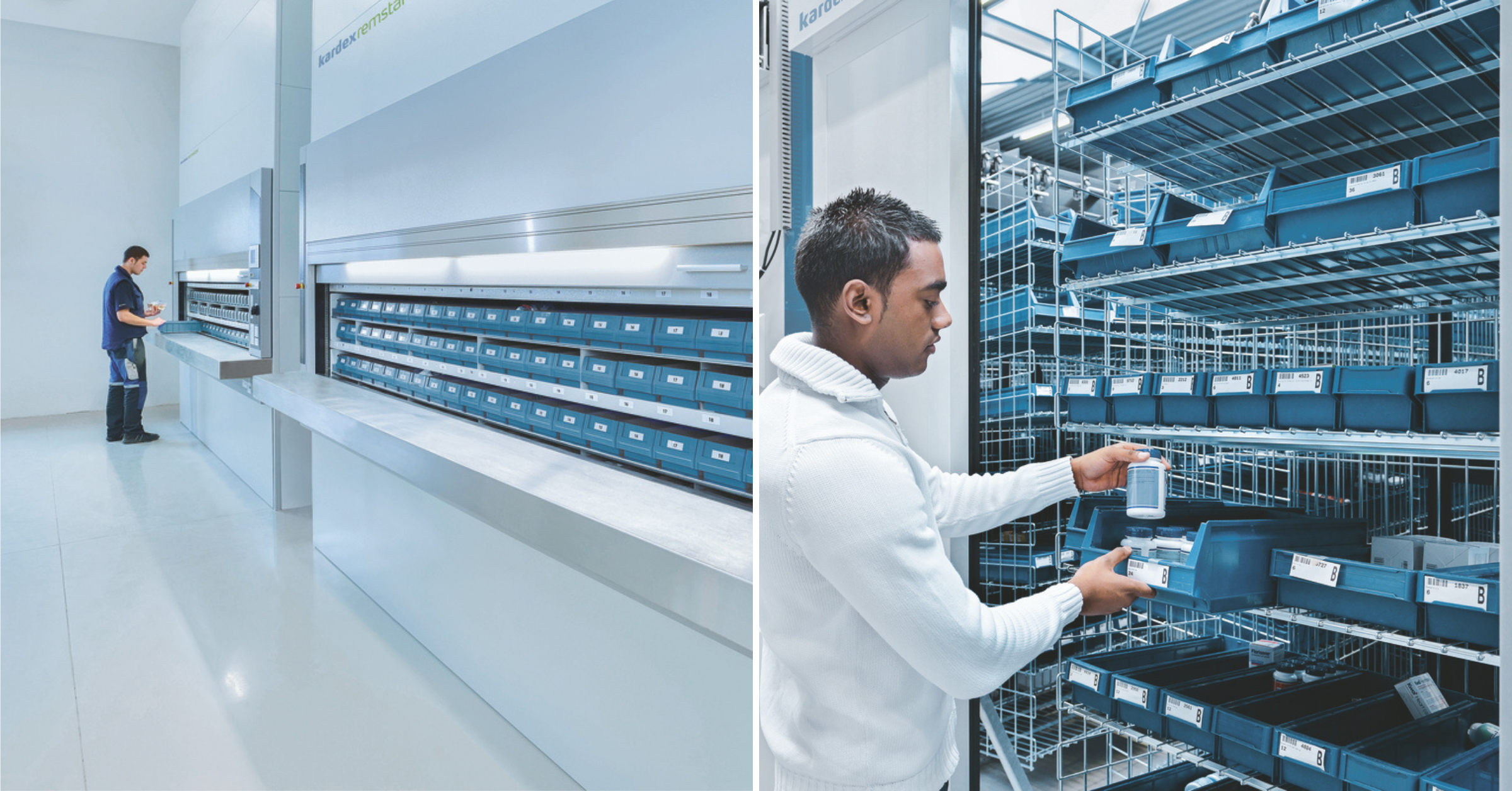Vertical Carousel vs. Horizontal Carousel: Which One Is Better for Your Warehouse
samanvya September 19, 2023 0 COMMENTS
Efficient storage solutions are crucial for modern warehouses facing the challenges of fast-paced logistics and increased customer demands. Automated storage and retrieval systems have changed the warehouse industry making it more efficient, safe, and less expensive to manage.
The two most popular warehouse storage systems currently in use are vertical and horizontal carousel systems. In this blog post, we explore the functionalities, advantages, and best use cases of both vertical and horizontal carousels to help you determine which option is better suited for your warehouse.
Without further ado, let’s jump in!
Table of Contents
What Are Vertical Carousels?
Vertical carousels are automated storage systems consisting of a series of vertically arranged shelves or carriers that rotate to bring items directly to the operator. This eliminates the need for manual travel and search, making the process aster and more convenient for warehouse workers.
Vertical carousels are designed for warehouses with limited floor space, making them a good choice for small businesses seeking to maximize their available space efficiently. They also provide additional security and inventory control, ensuring that valuable items are stored safely and accessed only by authorized personnel.
What Are Horizontal Carousels?
Horizontal carousels are automated storage systems made out of a series of bins or shelves arranged horizontally on an oval track, keeping items within easy reach of operators.
Using horizontal carousels allows for a fast picking time and great utilization of the warehouse floor space. Due to their design, this warehouse system is best suited for businesses with a diverse range of products and varying order profiles.
Horizontal carousels can be integrated with any warehouse management system and help streamline operations regardless of their size and the industry the warehouse operates.
Vertical Carousels vs. Horizontal Carousels
Both options have their benefits and downsides. Vertical carousels, on the one hand, excel in space optimization, making them suitable for warehouses with limited floor space. Horizontal carousels, on the other hand, offer quicker access to items, making them ideal for high-frequency orders.
The choice between vertical and horizontal carousels not only impacts storage efficiency but also has implications for ergonomics and worker safety. Vertical carousels bring items directly to the operator at an ergonomic height reducing the risk of injuries related to bending or reaching. At the same time, horizontal carousels require less movement for the operator, which can also contribute to improved worker safety.
In general, vertical carousels tend to have higher energy consumption, which is an important consideration for modern businesses. It’s crucial to take into account not only the additional cost associated with higher energy usage but also the environmental impact it may have.
Factors to Consider When Choosing Between Vertical and Horizontal Carousels
Choosing the warehouse automated system that suits your business is one of the most important decisions you’ll need to make as a business owner. There are a few important considerations to take into account when making this call.
Warehouse Layout and Size
Vertical Carousels are vertically oriented and require less floor space, while, horizontal carousels require more floor space due to their horizontal layout and oval track design. Using as much of your warehouse layout allows you to maximize storage capacity and speed up warehouse operations.
Type of Inventory
Vertical carousels are better suited for storing items with varying heights and sizes since they utilize adjustable shelves or carriers. Horizontal carousels, on the other hand, excel at handling smaller parts and high-frequency items, thanks to their quick rotation and access capabilities.
Picking Speed
The speed and efficiency of order picking are critical considerations in warehouse operations. Vertical carousels generally offer faster picking times due to their ability to bring items directly to the operator.
In contrast, horizontal carousels may have slightly longer access times since the operator needs to rotate the carousel to the desired position.
Best Practices for Implementing Vertical or Horizontal Carousels
Implementing vertical and horizontal carousels takes planning and effort to ensure optimal performance.
The first step is to thoroughly assess your warehouse before implementing any system. This includes considering the warehouse layout, the type of inventory you plan to store, and the intricacies of your operations.
Make sure that the installation is done by professionals to ensure the safety of both your goods and the warehouse workers.
Keep in mind that the employees using the carousels need to be trained beforehand. This increases efficiency and optimizes their performance so that the warehouse management system can be used to its fullest potential.
It’s also important to set up a maintenance and inspection schedule to keep the carousel system in optimal condition. Promptly address any issues to prevent disruptions in warehouse operations.
By adhering to these best practices, you can successfully implement vertical or horizontal carousels, improving warehouse efficiency and productivity.
To Sum Up
Choosing between vertical carousels and horizontal carousels is a crucial decision that significantly impacts your warehouse’s efficiency and overall productivity. While both systems offer unique advantages, the choice depends on your specific operational requirements, available space, and inventory characteristics.
Careful consideration of your warehouse’s operations and the type of items it stores is essential before selecting a complementary system. It’s equally important to assess how the chosen system will impact the day-to-day work of warehouse employees.
Striking the right balance ensures that the system empowers your workforce and enables your warehouse to thrive in the dynamic logistics landscape, gaining a competitive edge in the industry.
RELATED ARTICLES
Latest Articles
 Creating Dynamic Content Calendars Within a Headless CMSIn TipsMarch 27, 2025When you’re syndicating content for different […]
Creating Dynamic Content Calendars Within a Headless CMSIn TipsMarch 27, 2025When you’re syndicating content for different […] Florida’s Harsh Sun & Your Car: How to Prevent Paint Damage with PPFIn AutomotiveMarch 27, 2025Florida is known for its year-round sunshine, but that […]
Florida’s Harsh Sun & Your Car: How to Prevent Paint Damage with PPFIn AutomotiveMarch 27, 2025Florida is known for its year-round sunshine, but that […] 5 Cool Apps You Probably Didn’t Know AboutIn AppMarch 19, 2025We’ve all heard of mainstream apps such as Facebook, […]
5 Cool Apps You Probably Didn’t Know AboutIn AppMarch 19, 2025We’ve all heard of mainstream apps such as Facebook, […] Top 5 Most Downloaded Apps in the App Store in 2024In TipsMarch 13, 2025The App Store continues to be a hotspot for new and […]
Top 5 Most Downloaded Apps in the App Store in 2024In TipsMarch 13, 2025The App Store continues to be a hotspot for new and […] Top 5 Digital PR and Link-Building Agencies in 2025 for SEO GrowthIn TechnologyMarch 10, 2025In 2025, digital PR and quality backlinks will be […]
Top 5 Digital PR and Link-Building Agencies in 2025 for SEO GrowthIn TechnologyMarch 10, 2025In 2025, digital PR and quality backlinks will be […] How Long To Soak Chia Seeds: A Simple GuideIn TipsFebruary 11, 2025Chia seeds are little round black seeds that have […]
How Long To Soak Chia Seeds: A Simple GuideIn TipsFebruary 11, 2025Chia seeds are little round black seeds that have […] How to Spot Fake Software Licenses and Avoid ScamsIn TechnologyFebruary 4, 2025Image Credit: pexels.com In today’s complex […]
How to Spot Fake Software Licenses and Avoid ScamsIn TechnologyFebruary 4, 2025Image Credit: pexels.com In today’s complex […] What Factors Should Businesses Consider When Choosing A SIP Trunk Provider?In TechnologyFebruary 1, 2025Under the conditions that are related to running a […]
What Factors Should Businesses Consider When Choosing A SIP Trunk Provider?In TechnologyFebruary 1, 2025Under the conditions that are related to running a […] Best ATV Rentals in Dubai for Unforgettable Desert SafarisIn TravelJanuary 29, 2025Image Credit: pexels.com Dubai is a city that offers […]
Best ATV Rentals in Dubai for Unforgettable Desert SafarisIn TravelJanuary 29, 2025Image Credit: pexels.com Dubai is a city that offers […] The Evolution of Paint Protection Film: Innovations You Need to KnowIn TechnologyJanuary 26, 2025Over the years, Paint Protection Film (PPF) has […]
The Evolution of Paint Protection Film: Innovations You Need to KnowIn TechnologyJanuary 26, 2025Over the years, Paint Protection Film (PPF) has […] Your Ultimate Guide to Local SEOIn MarketingJanuary 17, 2025Local SEO can be defined as optimization of the online […]
Your Ultimate Guide to Local SEOIn MarketingJanuary 17, 2025Local SEO can be defined as optimization of the online […] Top 5 Reasons Why the Organic Traffic Is Really Beneficial for BusinessesIn MarketingJanuary 16, 2025Many companies invest heavily in SEO, with the […]
Top 5 Reasons Why the Organic Traffic Is Really Beneficial for BusinessesIn MarketingJanuary 16, 2025Many companies invest heavily in SEO, with the […]
stopie.com is a participant in the Amazon Services LLC Associates Program, an affiliate advertising program designed to provide a means for sites to earn advertising fees by advertising and linking to Amazon.com.
Clicking on an Amazon link from stopie.com does not increase the cost of any item you purchase.
We will only ever link to Amazon products that we think our visitors may be interested in and appreciate learning more about.



